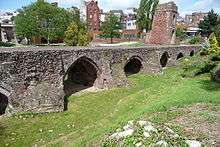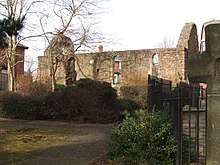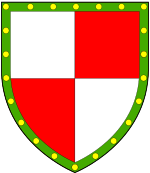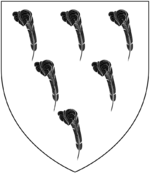Walter Gervais
Walter Gervais (fl. 1218) of the City of Exeter in Devon, England, was a wealthy merchant who served several times as Mayor of Exeter and who founded the Old Exe Bridge on the west side of the City crossing the River Exe. He is one of Prince's Worthies of Devon.[3]
Career
Walter served several times as Mayor of Exeter and was buried together with his wife in St Edmund's Church on the Exe Bridge.
Founds Exe Bridge

[5] One of the earliest historians to comment on the Exe Bridge was Richard Izacke (c.1624–1698), who in his 1677 work Antiquities of the City of Exeter wrote as follows:[6]
- 1250: Walter Gervis, a worthy citizen hereof founded Exbridge and collected (say some) £3,000 towards the building it, wherewith he purchased much land and bequeathed also his own for the maintenance of the same (ferry being here formerly kept) on which bridge a church was built (wherein this Gervis was now interred) dedicated to St Edmond, King of the East Angles.
Surviving documentary evidence shows that the bridge was in fact built between 1190 and 1210, and that the date of 1250 given by Izacke (and followed by Prince) is too late.
Builds St Loye's Chapel

According to the Devon historian Ethel Lega-Weekes (d.1949), it was Walter[7] Gervais, founder of the Exe Bridge, who in about 1238 built a chapel dedicated to St Loye (St Elegius) in the manor of East Wonford, outside the eastern walls of the City of Exeter, probably as his domestic chapel. The ruined walls of the Chapel survive today. East Wonford was later held by the Speke family, when it became known as "Wonford Speke".[8]
Marriage and children
He married and left children including:
- Nicholas Gervais, son and heir,[9] who at the start of the reign of King Henry III (1216-1272) was granted by Robert de Maundevill the estate of Ringswell in the parish of Heavitree,[10] (the place of executions) outside the eastern city walls of Exeter, "on the north side of the way where the gallowes stands".[11] He was the father of:
- Sir Walter Gervais, last in the male line, whose daughter and heiress Alice Gervais married Sir William Speke of Heywood[12] in the parish of Wembworthy in Devon. Her descendant was Sir John Speke (1442–1518) of Heywood[13] and of Bramford Speke both in Devon, and of Whitelackington in Somerset, Sheriff of Devon in 1517 and a Member of Parliament whose monument is the Speke Chantry in Exeter Cathedral in which survives his recumbent effigy. With Alice's consent Sir William Speke granted Ringswell it to Sir John Wiger.[14]
Gervais family
The Gervais family included the following, of unknown relationship to Walter Gervais:
- Thomas Gervais, a Citizen of Exeter, who in the late 13th. century[15] purchased the manors of Houndtor and Little Maneton from Thomas Langdon (grandson of Thomas Langdon (fl.1231)) and his grandmother Mabil. Both were subsequently sold by William Gervais, son of Thomas Gervais, to Walter Dymock of Lincolnshire[16] (possibly a member of the prominent Dymock family of Scrivelsby), who was involved in tin mining in Devon.
- Nicholas Gervais, who in 1301 held the manor of Milford from William Speke, son of William Speke. In 1325 Milford was held by Thomas Gervais.[17] A certain Thomas Gervais was Mayor of Exeter in 1337.[18]
References
- Pole, p.485
- Also in the 1564 Heraldic Visitation of Devon later the arms of "Jarvys of Stralling" (Vivian, Lt.Col. J.L., (Ed.) The Visitations of the County of Devon: Comprising the Heralds' Visitations of 1531, 1564 & 1620, Exeter, 1895, p.504)
- Prince, John, (1643–1723) The Worthies of Devon, 1810 edition, London
- https://historicengland.org.uk/listing/the-list/list-entry/1020671
- Prince
- Izacke, Richard, Remarkable Antiquities of the City of Exeter, first published 1677, (improved and continued to the year 1724 by Samuel Izacke), 3rd Edition, London, 1731, p.13
- "William Gervais" stated erroneously in place of "Walter Gervais", Ethel Lega-Weekes, Saint Loye’s, East Wonford, Devon, Transactions of the Devonshire Association, Vol 52, 1920, pp.360-366 From the age indicated by the masonry, I should not be surprised to find that St. Loye's Chapel had been erected by William (sic) Gervais, who in 1238 was an important land- holder in — if not co-lord of — the Manor of Wonford, and in Ringswell (Ft. of Fines, Dev. and Corn. Rec. Soc, No. 267). He was repeatedly Mayor (1218-1239), and founded Exe Bridge in 1250.
- Pole, p.234
- Pole, Sir William (d.1635), Collections Towards a Description of the County of Devon, Sir John-William de la Pole (ed.), London, 1791, pp.233;236;424-5
- Risdon, Tristram (d.1640), Survey of Devon, 1811 edition, London, 1811, with 1810 Additions, p.114
- Pole, p.233
- Pole, pp.233;236;424-5
- Pole, pp.424-5
- Pole, p.233
- Approximate timeframe, from details provided by Pole, p.265, he was the grandson of a man economically active in 1231, thus two generations later, say 25 years * 2 = 50 + 1231 = 1281
- Pole, p.265
- Pole, p.346
- Prince

